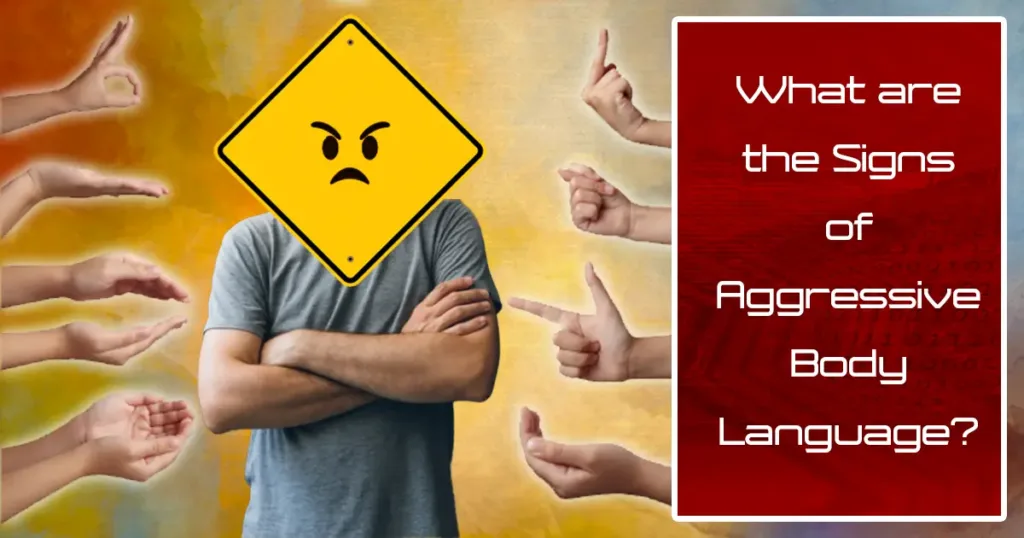Aggressive body language, an unspoken form of communication, plays a pivotal role in expressing dominance, anger, and potential hostility. This guide delves into understanding these non-verbal cues, crucial for personal safety and conflict avoidance. Recognizing the signs of aggressive body language is not just about self-protection; it’s about navigating social interactions more intelligently and safely.
The Foundation of Aggression in Body Language
The essence of aggressive body language lies in its ability to convey dominance and potential threat without a word spoken. Common manifestations include a rigid posture, arms crossed or hands on hips, clenched fists, and invasive personal space. These physical cues are often accompanied by piercing direct eye contact, sharp gestures, and facial expressions loaded with anger or disdain.
Cultural Nuances in Aggressive Expressions
While the core signs of aggression are universally recognized, cultural variations do exist. Western societies might interpret certain gestures as aggressive, which Eastern cultures perceive as assertive or respectful. This cultural lens is vital in accurately interpreting body language cues without misconceptions.
Key Signs of Aggressive Body Language
- Posture and Space Domination: An aggressive stance is often expansive, invading personal space to assert control or dominance.
- Intimidating Eye Contact: Prolonged, direct eye contact in this context aims to intimidate or challenge, a silent showdown of wills.
- Facial Expressions: Look for hardened features – narrowed eyes, furrowed brows, and tightened lips – all heralding aggression.
- Gestural Signals: Pointed fingers and wide-arm movements serve as extensions of one’s assertiveness, often perceived as threats.
- Vocal Projection: A raised, forceful tone accompanies aggressive body language, reinforcing the message of dominance or anger.
- Physical Contact: Unwelcome touching, such as grabbing or pushing, underlines a desire to physically control or intimidate.
Advanced De-escalation Techniques:
- Verbal De-escalation: Use calm, respectful language to address the aggressive individual. Acknowledge their feelings without agreeing or disagreeing, helping to defuse the situation. Phrases like “I understand this is frustrating” or “Let’s find a solution together” can be beneficial.
- Empathy and Understanding: Show genuine concern for the individual’s feelings and perspectives. Understanding the root of their aggression can provide insights into resolving the conflict peacefully.
- Boundary Setting: While it’s crucial to listen and empathize, setting clear boundaries about acceptable behavior is also necessary. Communicate your limits calmly but firmly.
Maintaining a Non-Threatening Posture:
- Body Language: Keep your hands visible and avoid making sudden movements that could be perceived as threatening. Adopt an open and relaxed stance to convey that you are not a threat.
- Spatial Awareness: Respect personal space. If possible, maintain a safe distance to prevent the situation from escalating due to perceived physical threats.
Cultural Sensitivity and Awareness:
- Understanding Cultural Differences: Recognize that interpretations of body language and aggression can vary significantly across cultures. What’s considered aggressive in one culture may be normal in another.
- Cultural Competence: Educate yourself on cultural norms and practices of the people you interact with. This knowledge can prevent misunderstandings and foster more effective communication.
Signs of Aggressive Body Language: Enhancing Situational Awareness
- Environment Analysis: Regularly assess your surroundings for exits, obstacles, and objects that could be used defensively or offensively. Being aware of your environment can help you identify escape routes or barriers to use in case of physical aggression.
- Behavioral Cues: Pay attention to not just the aggressive individual but also the behavior of bystanders. They can offer support, intervention opportunities, or additional risks.
Legal and Ethical Considerations:
- Know the Law: Familiarize yourself with local laws regarding self-defense and the use of force. Understanding legal boundaries is crucial for ensuring that your actions remain within the scope of the law.
- Ethical Response: Consider the ethical implications of your actions. Strive for solutions that prioritize the safety and well-being of all parties involved.
Incorporating these strategies into your approach to handling aggressive encounters can significantly improve your ability to navigate these situations safely and effectively. It’s about blending empathy, respect, and assertiveness to manage conflict without escalating aggression. Continuous learning and practice in these areas will enhance your proficiency in dealing with such encounters, contributing to a safer and more respectful interaction space for everyone.
Signs of Aggressive Body Language: Empowering Through Knowledge
At Grab The Axe, our commitment extends beyond mere awareness to empowering individuals and organizations with the tools and knowledge to enhance their security posture. Understanding the signs of aggressive body language is part of a broader spectrum of personal and professional safety strategies we advocate.
Signs of Aggressive Body Language: Take Action for Your Safety
Are you prepared to enhance your ability to recognize and respond to aggressive body language? Engage with Grab The Axe today. Subscribe to Grab The Axe Insights, follow us on social media, and immerse yourself in our resources to bolster your personal safety knowledge. From self-defense tools to the principles of situational awareness, we offer a comprehensive suite of resources tailored to your security needs.
Are you interested in a security assessment for your organization or a personal safety consultation? Schedule your session with Grab The Axe now and take a significant step towards a safer, more secure tomorrow.
References:
Schmidt, J. (n.d.). 9 Signs of Highly Aggressive Body Language. Body Language Info. Retrieved from https://bodylanguageinfo.com/aggressive-body-language/
Van Edwards, V. (n.d.). Aggressive Body Language: 15 Cues and How to De-escalate. Science of People. Retrieved from https://www.scienceofpeople.com/aggressive-body-language/
Signs of Aggressive Body Language – To Learn More:
Empower Yourself: Mastering Essential Self-Defense Skills for Ultimate Protection
Empower Your Safety: Mastering Situational Awareness in Personal Safety






This Post Has 4 Comments
Pingback: Empower and Safeguard: Prevent Sexual Assault Strategies - Grab The Axe
Pingback: 5 Shocking Secrets: Unmasking the Hidden Dangers of Aggressive Behavior
Pingback: Empower Your Safety: Mastering Situational Awareness Training for Ultimate Security - Grab The Axe
Pingback: 10 Essential Tips for Recognizing Aggressive Body Language to Ensure Personal Safety - Grab The Axe
Comments are closed.